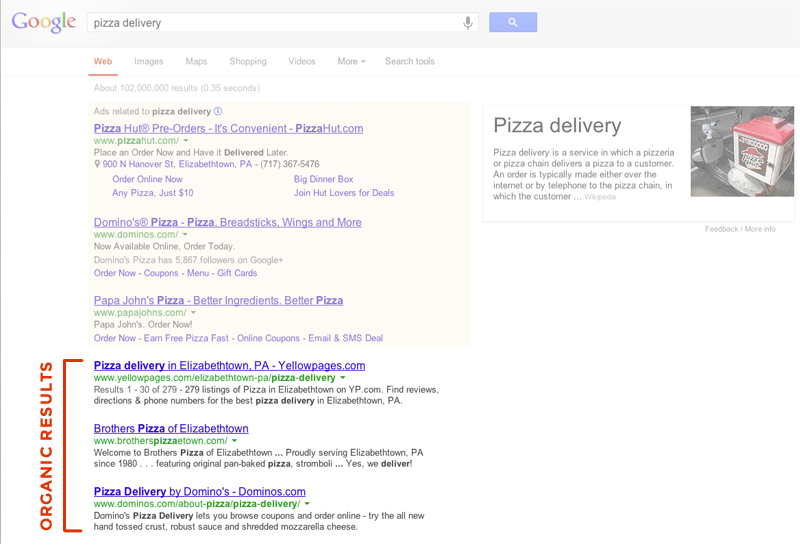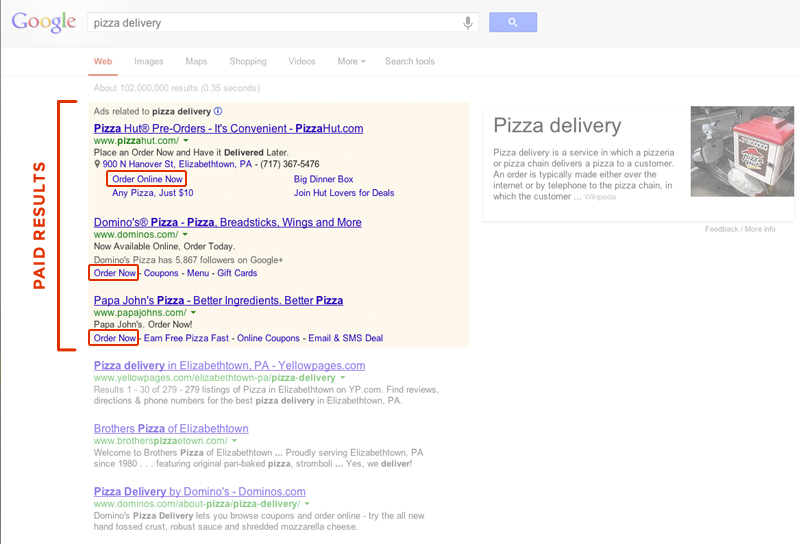The acronyms SEO and SEM have both become commonplace in the digital marketing landscape. Companies have learned that getting discovered online means appearing in what is known as search engine results pages (SERPs). To reduce confusion for digital marketing newcomers, I aim to prove that “SEO or SEM?” is the WRONG question. But first, I’ll provide some basic insight on both SEO and SEM services.
SEO
SEO, or search engine optimization, is an attempt to structure content and code in a way that will earn a website a higher position in SERPs. In other words, if you run a pizza shop, you may utilize SEO to get your website to show up in the first few spots when someone searches for “pizza delivery” in your local town.

SEO initiatives come with many benefits to a business. The number one benefit is guiding a steady stream of potential leads to a website without the need to pay for each visitor. Another top perk of SEO is if you can get far enough ahead of your competition, you can garner sustainable traffic without additional marketing costs.
However, these perks do not come easily. SEO’s biggest challenge is its long-term orientation. Because SEO is essentially the effort of gaining reputation for your website, much like you would as a new student vying for popularity in high school, it takes time, and immediate results are almost never achieved (unless you make starting quarterback upon arrival). Another disadvantage is if your company is in a highly competitive industry, battling your way to the top of search engines could be a very time intensive process.
SEM
Search Engine Marketing is the process of using tools like Google AdWords or Bing Ads, to pay for your website to appear on SERPs.
Similar to SEO, SEM also has benefits and setbacks. The biggest advantage to using SEM is the nearly instant results it provides. Additionally, SEM allows advertisers to more accurately guide customers or offer promotions, such as providing a direct link to order pizza with a promotional discount code included. Another perk is the time investment required for using SEM is far less than that required for SEO.

The biggest disadvantage to SEM is the cost. Search engine marketing requires the advertiser to pay for each click on their ads or for every 1,000 impressions. There is no opportunity for sustainable traffic without consistent investment. Another disadvantage that advertisers should be aware of is the lower click through rates of paid search results versus organic listings in the search engine results pages.
SEO or SEM?
At this point, you are likely weighing the pros and cons associated with SEO and SEM services and I must ask you to stop. As I stated, SEO or SEM is the wrong question. The proper approach is establishing a balance between the two initiatives.
An initial point of focus for both SEO and SEM is to target less competitive keywords. This allows for a few easy wins, while building momentum early on.
As mentioned, SEM will show instant traffic, while SEO will lag behind a few days (in the best case scenario) to a few weeks or months, depending on how competitive the keywords are that you’re targeting.
Once you start ranking organically for keywords that you’re paying for, it is time to transition your SEM target to a slightly more competitive group of keywords. This creates a ladder model where the next rung is just within reach, allowing your website to climb to the top of search engines.
Occasionally, you may want your SEO and SEM to overlap based on conversion or brand awareness goals. In regards to a conversion focus, a company may find that paying for search ads that use ad extensions, like click to call or targeted site links, may produce a greater number of conversions than just the organic listing alone.
Additionally, if a campaign has a brand awareness approach, the combination of winning on both SEO and SEM creates additional impression opportunities.
In both instances, if the path of overlap is selected, the company should be able to calculate the benefit of maintaining an SEO and SEM focus within the targeted keywords.
Do you use any other tricks when balancing your SEO and SEM services? Leave them in the comments below!